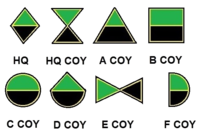Witwatersrand Rifles Regiment
| Witwatersrand Rifles | |
|---|---|

SANDF Witwatersrand Rifles emblem
|
|
| Active | 1 May 1903 to present |
| Country |
|
| Allegiance | |
| Branch | |
| Type | Infantry |
| Role | Mechanised infantry |
| Size | One battalion |
| Part of |
South African Infantry Formation Army Reserve |
| Garrison/HQ | Germiston |
| Motto(s) |
Pro Deo et Patria (Latin) (For God and Country) |
| March | Within a mile O' Edinburgh town |
| Anniversaries | 1 May 1903 (Regimental Day) |
| Battle honours | |
| Commanders | |
| Current commander |
Lt Col. G. Mazibuko |
| Colonel of the Regiment | Col. (Hon) J.L. Job, SM MMM JCD |
| Insignia | |
| Company level Insignia |  |
| SA Mechanised Infantry beret bar circa 1992 |
 SA mechanised infantry beret bar circa 1992 |
The Witwatersrand Rifles Regiment is a mechanised infantry regiment of the South African Army. As a reserve unit, it has a status roughly equivalent to that of a British Army Reserve or United States Army National Guard unit.
The Witwatersrand Rifles (often familiarly known as the "Wits Rifles") was formed on 1 May 1903 by members of the Railway Pioneer Regiment and the Rand Rifles, both of which had fought on the British side during the Second Anglo-Boer War of 1899 – 1902.
As befitted a regiment based from the gold-rich Witwatersrand region, it had a very close relationship with the mining establishment of the time; and its cap badge further emphasised this link.
The Regiment first saw action during the Bambata Rebellion of 1906, when it deployed a contingent to (the then) Zululand.
In 1907 the Regiment was further strengthened when it absorbed the Transvaal Light Infantry Regiment.
The regiment was mobilised again when World War I broke out. The first action that it took part in was the South African invasion of German South-West Africa (now Namibia). After the successful conclusion of this campaign, virtually all members volunteered for overseas service. Most of the volunteers were consequently assigned to the 3rd South African Infantry Battalion. (Due to the South African military law of the time, soldiers could not be forced to serve overseas, nor could existing military units be deployed there.)
The most well-known action that this unit took part in was the Battle of Delville Wood in the Somme. Other members of the regiment served in the Witwatersrand Rifles company of 7 South African Infantry Battalion; this unit which served in German East Africa against the forces of General von Lettow Vorbeck.
...
Wikipedia
